#then I did a wild Magic sorcerer run with him and the beautiful act 2 romance and the line ‘you give me hope’ I was like
Text
I'm running around Act 2 as my human Durge wild magic sorcerer, (wild magic is so much fun. I take tides of chaos ANY chance I get!) Astrid, AND I FORGOT HOW MUCH I LOVE THE SHADOWLANDS.
So dark. So mysterious. I don't want to leave. ALSO I found a new area I had never been to in my past 2 runs. I almost died because I was not prepared for the TWO fights I ran into.
ALSO WHY DID NO ONE TELL ME THAT TELLING ASTARION HE NEEDS A FRIEND AND NOT A LOVER IS SO TEAR INDUCING?!!?!
I'm romancing Gale for the first time but couldn't say no to Astarion. I knew there was a friend option later on, but had never seen it. It is so heartwarming and beautiful and now I want to make another character for him just to love and hold and cuddle and all the things he needs.
I fear I'll have to make a Tav/Durge for Astarion for every Tav/Durge I make for the other origin characters. Not to mention that I also want to play every origin character. I haven't even gotten Minthara on any playthrough so far (not for lack of trying on this one, I knocked her out, but aggro'd the goblin camp before I did that. WHOOPS), so I'm definitely doing a really dark embrace Durge with my sights set on her. Soo that means I need to have at LEAST 14 runs just to romance everyone and play the origin characters ONCE.
I will never be done with BG3.. aaaaand I don't see that as a bad thing.
#bg3#baldurs gate 3#baldurs gate iii#baldurs gate astarion#bg3 tav#baldurs gate durge#baldurs gate tav#bg3 durge#bg3 gale#baldurs gate gale#baldur's gate 3#baldur's gate iii
50 notes
·
View notes
Text
Last year I talked about Fantasia, which is not just one of my favorite Disney movies, but one of my favorite movies in general. And if I may be self-indulgent for a moment, it’s also one of the reviews that I’m the proudest of. Fantasia is a visual, emotional masterpiece that marries music and art in a manner few cinematic ventures have come close to replicating. One question that remains is what my thoughts on the long-gestated sequel is –
…you might wanna get yourselves some snacks first.
As anyone who read my review on the previous film knows, Fantasia was a project ahead of its time. Critics and audiences turned their noses up at it for conflicting reasons, and the film didn’t even make it’s budget back until twenty-something years later when they began marketing it to a very different crowd.

“I don’t wanna alarm you dude, but I took in some Fantasia and these mushrooms started dancing, and then there were dinosaurs everywhere and then they all died, but then these demons were flying around my head and I was like WOOOOOAAAHHH!!”
“Yeah, Fantasia is one crazy movie, man.”

“Movie?”
Fantasia’s unfortunate box office failure put the kibosh on Walt Disney’s plans to make it a recurring series with new animated shorts made to play alongside handpicked favorites. The closest he came to following through on his vision was Make Mine Music and Melody Time, package features of shorts that drew from modern music more than classical pieces.
Fast-forward nearly fifty years later to the golden age known as the Disney Renaissance: Walt’s nephew Roy E. Disney surveys the new crop of animators, storytellers, and artists who are creating hit after hit and have brought the studio back to his uncle’s glory days, and thinks to himself, “Maybe now we can make Uncle Walt’s dream come true.” He made a good case for it, but not everyone was on board. Jeffrey Katzenberg loathed the idea, partly because he felt the original Fantasia was a tough act to follow (not an entirely unreasonable doubt) but most likely due to the fact that the last time Disney made a sequel, The Rescuers Down Under, it drastically underperformed (even though the reasons for that are entirely Katzenberg’s fault. Seriously, watch Waking Sleeping Beauty and tell me you don’t want to punch him in the nose when Mike Gabriel recalls his opening weekend phone call).
Once Katzenberg was out of the picture, though, Fantasia 2000, then saddled with the less dated but duller moniker Fantasia Continued, got the go-ahead. Many of the sequences were made simultaneously as the animated features my generation most fondly remembers, others were created to be standalone shorts before they were brought into the fold. Since it was ready in time for the new millennium, it not only got a name change but a massive marketing campaign around the fact that it would be played on IMAX screens for a limited run, the very first Disney feature to do so. As a young Fantasia fan who had never been to one of those enormous theaters before, I begged and pleaded my parents to take me. Late that January, we traveled over to the IMAX theater at Lincoln Center, the only one nearest to us since they weren’t so widespread as they are now, and what an experience it was. I can still recall the feeling of awe at the climax of Pines of Rome, whispering eagerly with my mom at how the beginning of Rhapsody in Blue looked like a giant Etch-A-Sketch, and jumping twenty feet in the air when the Firebird’s massive eyes popped open. But did later viewings recapture that magic, or did that first time merely color my perception?
We open on snippets from the original Fantasia…IN SPAAAAAAAAACE!
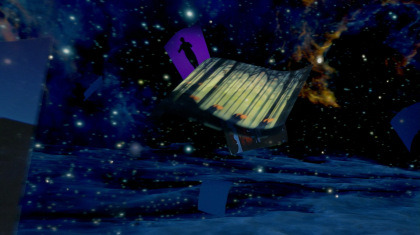
It reminds me a little of the opening to Simply Mad About The Mouse, where bits of classic Disney nostalgia fly about to evoke the mood of this upcoming musical venture. In a clever conceit, snippets of Deems Taylor’s original opening narration explaining Fantasia’s intent and music types plays over the orchestra and animators materializing and gearing up for the first sequence, which jumps right into –
DUN DUN DUN DUUUUUUN – I mean, Symphony #5 – Ludwig Van Beethoven
Here, a bunch of butterflies flee and then fight off swarms of bats with the power of light – I can’t be the only one who saw these things and thought it was butterflies vs. bats, right?
It does look cool with its waterfalls and splashes of light and color bursting through the clouds, but this brings me to a bit of contention I have with the movie.
When I planned this review I was going to do a new version of “Things Fantasia Fans Are Sick of Hearing”, except there were only four major complaints I could think of that. On further introspection, I admit they are legitimate grievances worth addressing. I’m going to get them out of the way all at once in order to keep things rolling.
#1 – This Seems Familiar…
Certain sequences are noticeably derivative from the first movie. It’s as if they were afraid of trying too many new things that would alienate audiences so they borrowed from their predecessor in an effort to say “Hey, we can do this too!” Symphony #5 is clearly trying to be Tocatta and Fugue with its abstract geometric shapes swooping all over to kick things off. Though I love how much character the animators managed to give two pairs of triangles, Tocatta’s soaring subconscious flights of fancy leaves me more enthralled. Carnival of the Animals literally began as a sequel to Dance of the Hours until the ostriches became flamingoes. And Roy E. Disney openly stated he wanted the last sequence, The Firebird Suite to have the same death and rebirth theme as Night on Bald Mountain/Ave Maria, which they got, right down to a terrifying symbol of destruction emerging from a mountain to wreak chaos.
‘Sup, witches?
#2 – Too Short
Speaking of repeating the past, the original idea for Fantasia 2000 was to follow Walt’s vision in that three favorite segments would make a return amongst the newer ones – the Nutcracker Suite, which was eventually cut for time, Dance of the Hours, which I’ve already stated morphed into Carnival of the Animals, and finally, The Sorcerer’s Apprentice, the obvious choice to keep since that’s the most popular piece out of any of them. Cutting things for time doesn’t make that much sense, however, when you realize that Fantasia 2000’s runtime is only 75 minutes. A very short animated film by today’s standards that lasts barely half as long as its previous installment. I don’t see why they couldn’t keep at least one other sequence from the first Fantasia to make things last a little longer and keep in the original idea’s spirit.
#3 – All Story, No Experimentation
Unlike the first Fantasia, all of the sequences have a linear narrative structure that’s easy to follow. Not a bad thing and kudos to you if you’re among that group who prefers Fantasia 2000 for because of that, but again, I admire how the original film didn’t stick to a coherent story the whole time; how it was unafraid to let the music, atmosphere, and visuals speak for itself without sticking to a three-act plot and designated protagonist for every piece.
#4 – The One You’ve Been Waiting For, The Host Segments
One of the things that turned Fantasia off for its detractors was Deems Taylor’s seemingly dry narration. But maybe Fantasia 2000 can fix that with some folks who are hip and with it, perhaps a wild and crazy guy or two…

Eh, he’ll do.
Now, the idea of varying segment hosts isn’t an altogether bad idea. Most of them work well: Angela Lansbury gives the lead-in to the Firebird Suite plenty of gravitas befitting the finale, as do Ithzak Perlman, Quincy Jones, and James Earl Jones, who build plenty of intrigue for Pines of Rome, Rhapsody in Blue and Carnival of the Animals respectively; this seriousness makes James’ reaction to what the Carnival segment is really about a successful comic subversion. Even Penn and Teller for all their obnoxiousness kind of works with The Sorcerer’s Apprentice due to the linking magic theme.
I suppose what turns people off is the self-congratulatory tone and seemingly forced attempts at comedy you get from Martin, Penn, Teller, and Bette Midler. But you know what? They still make me laugh after all these years (well, you have to laugh at Bette Midler’s antics or she’ll come after you when the Black Flame Candle is lit). In fact, I have to hand it to Midler’s intro in particular. Fantasia 2000 came out right around the time I began taking a keen interest in what animation really was and how it was made. For me, her preceding The Steadfast Tin Soldier piece with tidbits about Fantasia segments that didn’t make it past the drawing board was like the first free hit that turned me into an animation junkie (plus this was before you could look up anything on the topic in extraneous detail on the internet, so it had that going for it). If I have to nitpick, though, The Divine Miss M referring to Salvador Dalí as “the melting watches guy” is a bit reductive. That’d be like calling Babe Ruth “the baseball guy” or Walt Disney “the mouse and castle guy”. Plus, Dalí and Disney were close compadres with a layered history. They planned on many collaborations, though the fruit of their labors, Destino, would not be completed in either of their lifetimes. Couldn’t show just a modicum of respect there, Bette?

Ahhh! I take it back! Don’t steal my soul!
So, I wouldn’t say I hate or even completely dislike the host segments. Sorry to disappoint everyone who was hoping for me to rip into them. They’re not awful, just uneven. And if you think they ruin the movie for me, you’ve got another think coming.
Pines of Rome – Ottorino Respighi
The idea for Pines of Rome’s visuals came about due to an unusual detail in some concept art. Someone noticed that a particular cloud in a painting of the night sky heavily resembled a flying whale. So why make a short about flying whales? The better question would be why NOT make a short about flying whales? A supernova in the night sky miraculously gives some whales the ability to swim through the air over the icy seas. Again, seeing this in IMAX was incredible. There’s just one minor issue I have with. This and another segment were developed well before Pixar made its silver screen debut, and unfortunately, it shows twenty years later; the worst cases are the close-ups.
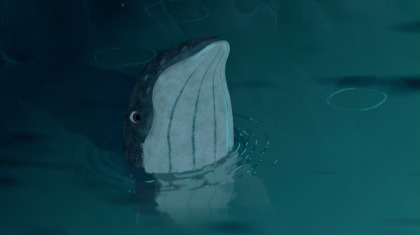
Okay, who put googly eyes on the moldy beanbag?
There are ways of blending CGI and hand-drawn animation well, and this isn’t one of them. I understand the necessity of having expressive eyes but simply dropping one on top of a CGI creature gives it a bit of an uncanny valley feel. They should have either stuck with traditional all the way or made the whales entirely CG. The CG animation of the whales themselves isn’t too shabby, so they could have pulled it off.
Because simply giving whales flight apparently isn’t enough to hold an audience’s interest, we have an adorable baby whale earning his wings, so to speak. Once he gets his bearings above the surface, he swoops ahead of his family and bothers a flock of seagulls. They chase him into a collapsing iceberg, leaving him trapped, alone and unable to fly. The quiet dip in the music combined with the image of this lost little calf adds some genuine emotional weight to this piece. The baby navigates the iceberg’s claustrophobic caverns until he finds a crevice that elevates him back to his worried parents. From there a whole pod of whales rises out of the ocean to join them as they fly upwards to the supernova’s source.
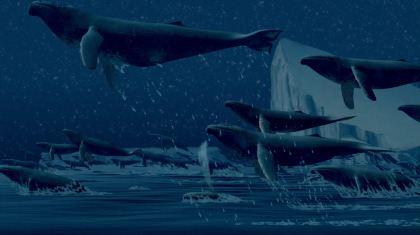
“So long, and thanks for all the krill!”
As the music reaches its brilliant crescendo, the whales plow through storm clouds until they reach the top of the world and breach through the stars like water. It’s an awe-inspiring climax of a short that, flaws and all, reminds you of what Fantasia is all about.
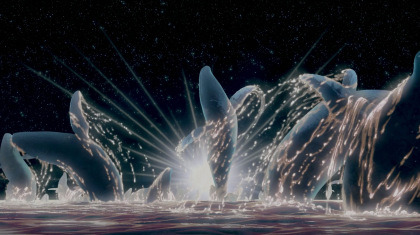
Majestic.
Rhapsody in Blue – George Gershwin
The music of jazz composer George Gershwin? Timeless. The art of renowned caricaturist Al Hirschfeld? Perfection. All this brought to life with the best animation Disney has to offer? It’s a match made in heaven. Eric Goldberg, who animated the Genie among other comedic characters, idolized Hirschfeld and drew plenty of inspiration from drawings, so getting to work alongside him while making this was nothing short of a dream come true. That attention to detail in rendering Hirschfeld’s trademark curvy two-dimensional style goes beyond mere homage. It is a love letter to a great artist that encapsulates everything about him and his craft, and to a great city that we both had the honor of calling home. The story goes that Goldberg screened the final product for Hirschfeld shortly before his 96th birthday and his wife told him after that it was the best gift he could have ever received.
All this to say I am quite fond of this particular short, thank you very much.
The piece follows four characters navigating 1930’s Manhattan and crossing paths over the course of a single day:
Duke, a construction worker torn between his steady, monotonous job and following his dream of drumming in a jazz band,
Joe, a victim of the Great Depression desperately looking for work,
Rachel, a little girl who wants to spend time with her parents but is forced to attend lesson after lesson by her strict governess,
and “Flying” John, a henpecked husband longing to be free from his overbearing wife –
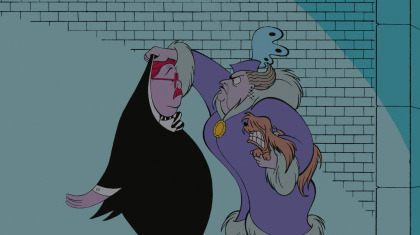
And her little dog too!
By the way, John is modeled in name and in looks after Disney animation historian John Culhane, who also was the inspiration for The Rescuers’ Mr. Snoops, hence why the two look so similar. He’s not the only name who appears in this sequence: Gershwin himself makes a surprise cameo as he takes over Rachel’s piano solo halfway through the story.
Speaking of, my family used to compare me to Rachel because at that point in my young life I was doing or already did the same mandatory activities as she – swimming, ballet, music, sports, all with the same amount of speed and varying degrees of success.
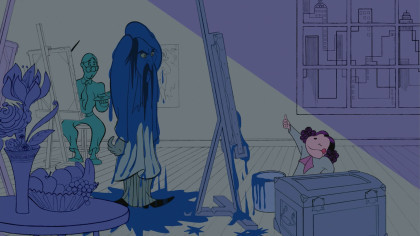
No one can argue that art is where we both excelled, however.
The physical timing of Rhapsody in Blue’s animation is hilarious, though it doesn’t rely wholly on slapstick for its humor. The sight gags and clever character dynamics all weaved into the music milk plenty of laughs, and envelop you in this living, breathing island that is Manhattan.
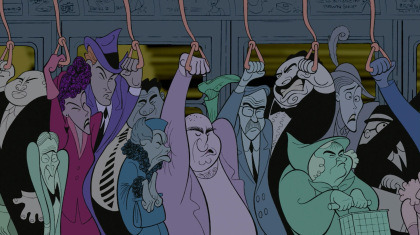
I speak from experience, this is the most accurate depiction of commuting on the 1 train that there ever was.
Even with such a premise and two masters of combining comedy and art, there is still enough pathos to keep the story rooted. Take when all four characters are at their lowest point. They look down on some skaters in Rockefeller Center and picture themselves in their place fulfilling their deepest desires. Seeing their dreams so close in their minds and yet so far away while paired with the most stirring part of the score is heartwrenching.
In the end, things pick up as the characters unwittingly solve each other’s problems. Duke quits the construction site, leaving an opening for Joe to fill. Joe accidentally snags John’s wife on a hook and hauls her screaming into the air, allowing him one night of uninhibited fun at the club where Duke performs.
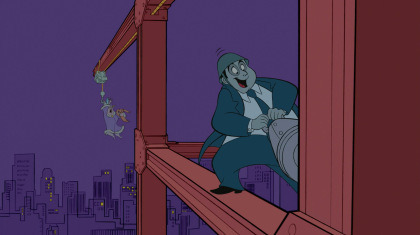
“Anyone hear something? Nah, it’s probably just me.”
Rachel loses her ball while fighting with her nanny, which Duke bounces off the window of her parents’ office, which in turn gets them to notice their daughter about to run into traffic and they save her. Everyone gets their happy ending and it ends on a spectacularly glamorous shot of Time Square lit up in all its frenetic neon glory.

And not a single knockoff costumed character hitting up tourists for photos. Those were the days, my friend.
If you haven’t guessed by now, I adore Rhapsody in Blue. It’s easily my favorite part of the movie; a blissful ménage-a-trois of art style, music and storytelling, and it’s so New York that the only New York things I could think of that are missing are Central Park and amazing bagels. This sequence is gut-busting, energized, emotional, and mesmerizing in its form. I don’t often say I love a piece of animation so much that I’d marry it, but when I do, it’s often directed at Rhapsody in Blue.
Piano Concerto #2 – Dmitri Shostakovich (aka The One With The Steadfast Tin Soldier)
This piece has an interesting history attached to it. Disney wanted to do an animated film surrounding Hans Christian Andersen’s fairy tales – including The Little Mermaid and The Steadfast Tin Soldier – as far back as the 30’s, but the project fell by the wayside. During Fantasia 2000’s production, Roy E. Disney asked if they could do something with Shostakovich’s Piano Concerto #2 since he and his daughter were attached to that piece. He looked over sketches and storyboards made for the unrealized Tin Soldier sequence and discovered the music matched in perfect time with the story.
This is the second sequence that features CGI at the forefront. Unlike Pines of Rome, though, it works because the main characters are toys, and you can get away with your early CGI looking shiny and metallic and plastic-like when you’re animating toys.
Hell, it worked for Pixar.
The story centers on a tin soldier cast with only one leg who is shunned by his comrades for routinely throwing off their groove. He falls in love with a porcelain ballerina when he mistakes her standing en pointe as her also missing a limb. Despite his embarrassment when he learns the truth, the ballerina is enamored with him as well. This rouses the jealousy of an evil jack-in-the-box who I swear is a caricature of Jeffrey Katzenberg minus the glasses but with a goatee and Lord Farquaad wig.
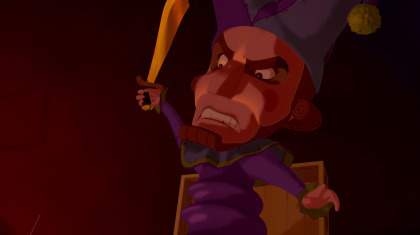
“MUST. CHOP. EVERYTHING!!!”
The jack-in-the-box and the soldier duke it out for a bit before the former sends the latter flying out the window in a little wooden boat. The boat floats the soldier into the sewers and attracts a horde of angry rats who attack him, because animated rodents seem to have a natural hatred towards toy soldiers.
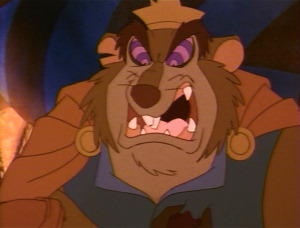
Case in point.
The soldier hurtles into the sea where he’s eaten by a fish – which is caught the following morning, packed up to be sold at market, bought by the cook who works at the very house he came from, and he falls out of the fish’s mouth on the floor where his owner finds him and places him back with the rest of the toys. Now the story this is based on hints that the jack-in-the-box is really a goblin who orchestrates the soldier’s misfortunes with his malicious magic. But based the extremely coincidental circumstances of his return home, I’d say the soldier’s the one who’s got some reality-warping tricks up his sleeve.
The soldier and jack-in-the-box duel again that evening, but this time the harlequin harasser falls into the fireplace and burns up. Our hero gets the girl and lives happily ever after. A nice conclusion, though a far cry from what happened in the original tale: the ballerina is knocked into the fire, the soldier jumps in after her, and all that remains of them by morning is some melted tin in the shape of a heart. I gotta say, for all my love of classic fairytales, Disney made the right call. Andersen’s life was far from magical and it reflected in his stories, making many of them depressing for no good reason. The triumphant note the music ends on also would have clashed horribly if they stuck with the original. Even the Queen of Denmark agreed with Disney’s decision to soften their adaptations of Andersen’s work. I don’t know if I’d call The Steadfast Tin Soldier one of my very favorite parts of Fantasia 2000, but in the end, s’all right.
Carnival of the Animals: Finale – Camille Sant-Saëns
This shortest of shorts (clocking in at less than two minutes) kicks off with James Earl Jones asking with as much seriousness as he can muster from the situation, what would happen if you gave a yo-yo to a flock of flamingos?
The answer –
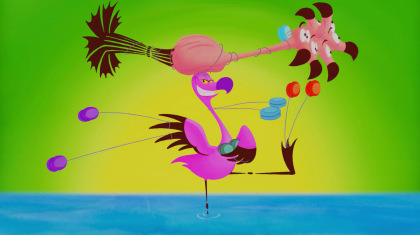
Good answer!
Fie on those who dismiss this part as a silly one-off that doesn’t belong here. Fie, I say! It’s a pure delight full of fun expressions and fluid fast-paced action. Once again we have my man Eric Goldberg to thank for this, though this time he animated it entirely by himself. I’d call it a one-man show except for the fact that his wife Susan handpainted the entire thing with watercolor, making it look like it sprung to life straight from a paintbrush. It’s a simple diversion about a flamingo who wants to play with his yo-yo while the other snooty members of his flock try to force him to conform. As you can see from the still, they fail quite epically. Nothing beats the power of nonconformity and yo-yos (also every yo-yo move featured here is authentic; I love when animators go that extra mile).
The Sorcerer’s Apprentice plays next, but since I already touched on that in the first Fantasia review, I’m skipping over it. The segment ends with Mickey congratulating Leopold Stokowski (again), then crossing the barriers of time and space to inform the conductor, James Levine, that he needs to track down the star of the next segment, Donald Duck. Levine stalls by explaining a bit about what’s to come while Mickey frantically searches for his errant costar. The surround sound sells the notion of him moving around the back of the theater accidentally causing mischief all the while. Thankfully, Donald is found and the sequence commences.
Pomp and Circumstance – Edward Elgar
This famous piece of music was included at the insistence of Michael Eisner after he attended his son’s graduation ceremony. He wanted to feature a song that everyone was already familiar with. Of course, since this was after Frank Well’s untimely passing and no one was bold enough to temper Eisner’s worst instincts with common sense, his original pitch had every animated couple Disney created up to that point marching on to Noah’s Ark – and then marching out with their babies.
youtube
Okay, A: Unless you’re doing a groin hit joke or are Ralph Bakshi or R. Crum, cartoon characters don’t have junk as a rule. And B, one of the unwritten rules of Disney animation is that barring kids that already exist like the titular 101 Dalmatians or Duchess’ kittens, the established canon couples do not in any official capacity have children.
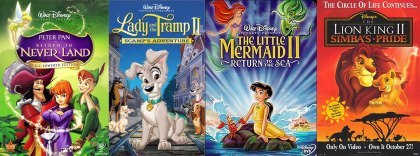
To which Eisner laughed maniacally and vowed that they would.
But in order to placate Eisner’s desire to turn every branch of the Disney corporation into a commercial for itself, the animators compromised and agreed to do Pomp and Circumstance with the Noah’s Ark theme, BUT with only one couple – Donald and Daisy Duck. In this retelling of the biblical tale, Donald acts as Noah’s beleaguered assistant (I guess Shem, Ham, and Japheth were too busy rounding up the endangered species). Daisy provides emotional support while preparing to move on to the ark as well. It’s refreshing to see these two not losing their temper at each other for a change. I wish we got to see this side of their relationship more often. Donald returns Daisy’s easily lost plot device locket to her and as the rain rain rain comes down down down, he starts directing the animals on board; the lions, the tigers, the bears, the…ducks?
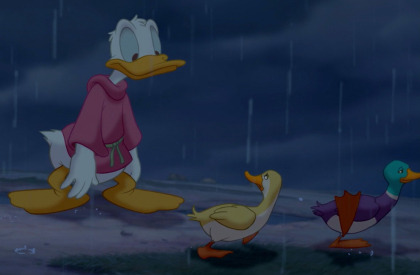
Anyway, all the animals and Donald get on board – well, most of them do.

The world’s first climate change deniers.
Donald realizes Daisy hasn’t arrived yet and runs out to look for her, unaware that she’s already boarded. Daisy sees Donald leaving but is too late to stop him before the first floodwaters hit their home. Donald made it back to the ark in time, however, though both of them believe that the other is forever lost to them. I find it astounding that they never run into each other not even once during the forty days and forty nights they’re cooped up on that boat. It’s the American Tail cliche all over again, and well, at least it’s happening in a short and not the entire movie.
Soon the ark lands atop Mount Ararat and the animals depart in greater numbers than when they embarked on their singles cruise. Daisy realizes halfway down the mountain that she’s lost her locket again, which Donald finds at that very moment while sweeping up, and the two are joyously reunited.
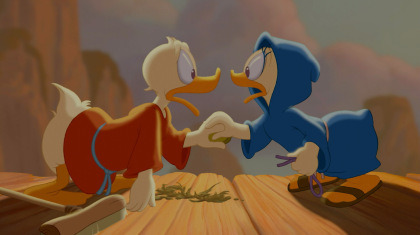
“I thought you were dead!” “I thought YOU were dead!”
I kid around, but I truly enjoy this short a lot. There’s so much warmth to Donald and Daisy’s relationship that makes their reunion at the end all the sweeter, and there’s plenty of great slapstick to offset the drama in the meantime. I will admit it’s nice to hear there’s more to Pomp And Circumstance than just the famous march, and the entire suite matches flawlessly with the visuals, though the main theme itself is so ingrained into the public consciousness that it’s difficult to extricate it from that what we’ve seen accompany it countless times.
Come on, you all know what I’m talking about.
youtube
“What? Don’t tell me YOU don’t think of heads exploding like fireworks when you hear Pomp and Circumstance! Name one other life-changing moment could you possibly associate it with…you weirdo.”
The Firebird Suite – Igor Stravinsky
Fantasia 2000 comes to a close with a piece that has some emotional resonance if you know your history. You might remember from my first Fantasia review that Igor Stravinsky was disappointed with how Rite of Spring turned out, especially since he was a big admirer of Walt Disney and really wanted to do more projects with him beforehand. I don’t think it’s a coincidence that they picked his premiere ballet to end the movie on decades later. After all these years, Disney worked hard to do right by Stravinsky – with a few twists, though. Instead of a balletic retelling of Russian folktales involving kidnapped princesses and immortal sorcerers, we have a fantastical allegory for the circle of life.
No, not that circle of life.
A lone elk who I’m fairly convinced is the Great Prince of the Forest walks through the forest in the dead of winter. With his breath, he awakens the spirit of the woods and one of the most beautiful characters Disney has ever created, the Spring Sprite.
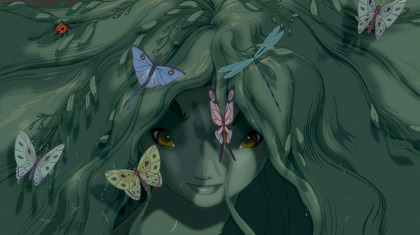
I. Love. This character. Her design is gorgeous, shifting from a shimmery opalescent blue as she steps out of the water into an eternally flowing fount of live greenery spreading from her hair in her wake. Wherever she moves, grass, flowers, and trees blossom, fulfilling the idea of a springtime goddess more than Disney’s own Goddess of Spring ever did. The Sprite was a massive influence in developing my art style, particularly in her face and expressive eyes, and I used to draw her a lot. Visit any relative of mine and chances are you’ll find a picture of her by me hanging up on a wall somewhere in their house. Yet there’s far more to her character than just a pretty representation of nature; there’s plenty of curiosity, spunk, determination, and a drive for creativity. I love her frustrated expression when she’s dissatisfied with the tiny flower she sculpts out of the ground and how her face lights up when she morphs it into a buttercup as tall as she is.
The Sprite paints the forest with all the colors of the wind (mostly green) until she reaches a mountain that isn’t affected by her magic. Perplexed, she climbs it until she finds a large hunched over rock figure – or is it an egg? – standing inside. She reaches out to touch it and…


The Sprite has awakened her counterpart, the wrathful and deadly Firebird. Think giant evil phoenix made of smoke, flame and lava. And it goes without saying that seeing this on the biggest screen left quite the terrifying impact. One of the biggest inspirations for this sequence was the eruption of Mount St. Helens (though the shot of the Sprite surveying the breadth of the Firebird’s destruction reminds me far too much of the Australian bushfires going on) and the sheer horror of nature’s irrepressible chaos is fully captured here. But the Firebird refuses to settle for merely destroying the Sprite’s handiwork, oh no. It won’t rest until creation itself is consumed, and the Sprite is reduced to a powerless mite as she scrabbles to escape the Firebird’s relentless pursuit of her. Try as she might, however, the towering monster corners and devours her in one fell swoop.
The forest is reduced to gray ashes in the wake of the Firebird’s rampage, but the Great Prince has survived. Once again he brings the Sprite to life with his breath, only this time she is tiny and weak (the animation of her slowly developing from the ash into her huddled ragged form is breathtaking). Now, I didn’t think I’d get emotional revisiting a small part of a single movie I’ve rewatched countless times before but viewing this through a mature eye combined with the beauty of the Firebird Suite’s climax and its timely message has caused me to see it in a new light:
The Sprite is utterly broken by what she’s been through and the destruction she carelessly caused. She’s lost all faith in herself and in the idea of returning the forest to what it once was. Even so, the Prince gently insists on carrying her on his antlers to the remains of their favorite cherry blossom tree. Where her tears fall, grass shoots begin to sprout. This fills the Sprite with hope, and she soars into the air becoming one with the sky and rains life down on the forest. New trees burst from the earth. The air is filled with leaves and pollen and new life flowing from her essence. The Sprite’s joy and power grow so strong that she even encircles the Firebird’s mountain in all her verdant glory. Life and creation overcome death and destruction. It’s not Night on Bald Mountain/Ave Maria, but it’s close.
And unfortunately, that’s the biggest problem Fantasia 2000 has.
While working on the original Fantasia, a storyman made the mistake of referring to the work they were doing in “the cartoon medium” in Walt’s presence. Walt turned on him and snapped “This is NOT ‘the cartoon medium’. It should not be limited to cartoons. We have worlds to conquer.”
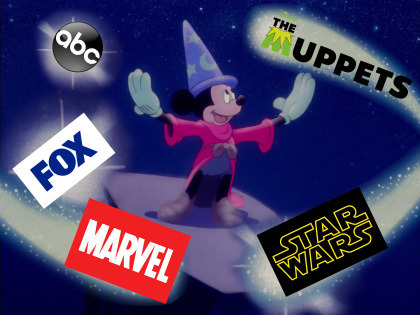
And conquer they did…just not the way Walt intended.
The point I’m trying to make is Walt was breaking new ground and experimenting with things nobody ever tried when it came to Fantasia. While those risks were initially deemed a failure, it eventually gained the recognition it deserved from the animation and filmmaking community. Any attempt to recreate the magic of Fantasia is no small feat. But rather than taking new risks that not even the first film dared, the studio opted to adhere to Fantasia’s formula with pieces that recall if not flat out copy from the original segments. I hesitate to call it a pale imitation or cash grab however because this was done for the art much more than the money (though Eisner was probably hoping it would bring in some bank). There’s even a little bit of depth to it: while the first Fantasia had themes of differing natures in conflict – light vs. dark, fire vs. water, etc. – Fantasia 2000’s theme is accidental but brilliantly meta: CGI vs. traditional animation, a conflict Disney would become very familiar with in the decade following the film’s release. In some ways, it reminds me of Epcot’s genesis. The driving force behind it was long gone, but the attempt to bring it to life as close to the original vision as possible is still much appreciated.
For all my gripes, I really do enjoy Fantasia 2000. Perhaps not on the same level as its predecessor, but it has its moments, oh yes. And believe me, as far as Disney sequels go, you could do far, far, far worse than this one. Fantasia 2000 is Fantasia’s kid sister mimicking its beloved older sibling in an attempt to show it can be cool like the big kids too. But hey, imitation is the sincerest form of flattery.
Thank you for reading! If you enjoyed this review, please consider supporting this misfit on Patreon. Patreon supporters receive great perks such as extra votes for movie reviews, movie requests, early sneak-peeks and more! If I can hit my goal of $100 a month, I can go back to weekly tv series reviews. As of now, I’m only $20 away! Special thanks to Amelia Jones, Gordhan Rajani and Sam Minden for their contributions! I’ll see you in a few weeks when I and review the 1959 Disney animated classic, Sleeping Beauty!
Artwork by Charles Moss.
Screencaps from animationscreencaps.com
Yes, I know The Lion King and Lady and the Tramp ended with the titular characters having babies, but was there anyone out there apart from Eisner who demanded there be sequels to those films that focused on their offspring?
January Review: Fantasia 2000 Last year I talked about Fantasia, which is not just one of my favorite Disney movies, but one of my favorite movies in general.
#2000#2000&039;s#2D animation#action#al hirschfeld#angela lansbury#animated#animated feature#animated movie#animated movie review#animated musical#animated short#animated shorts#animation#animator#animators#anthropomorphic animals#art#ballerina#Beethoven#bette midler#brave tin soldier#Camille Saint-Saëns#Carnival of Animals#Carnival of the Animals#carnival of the animals finale#cgi animation#computer animation#continuation#continued
1 note
·
View note